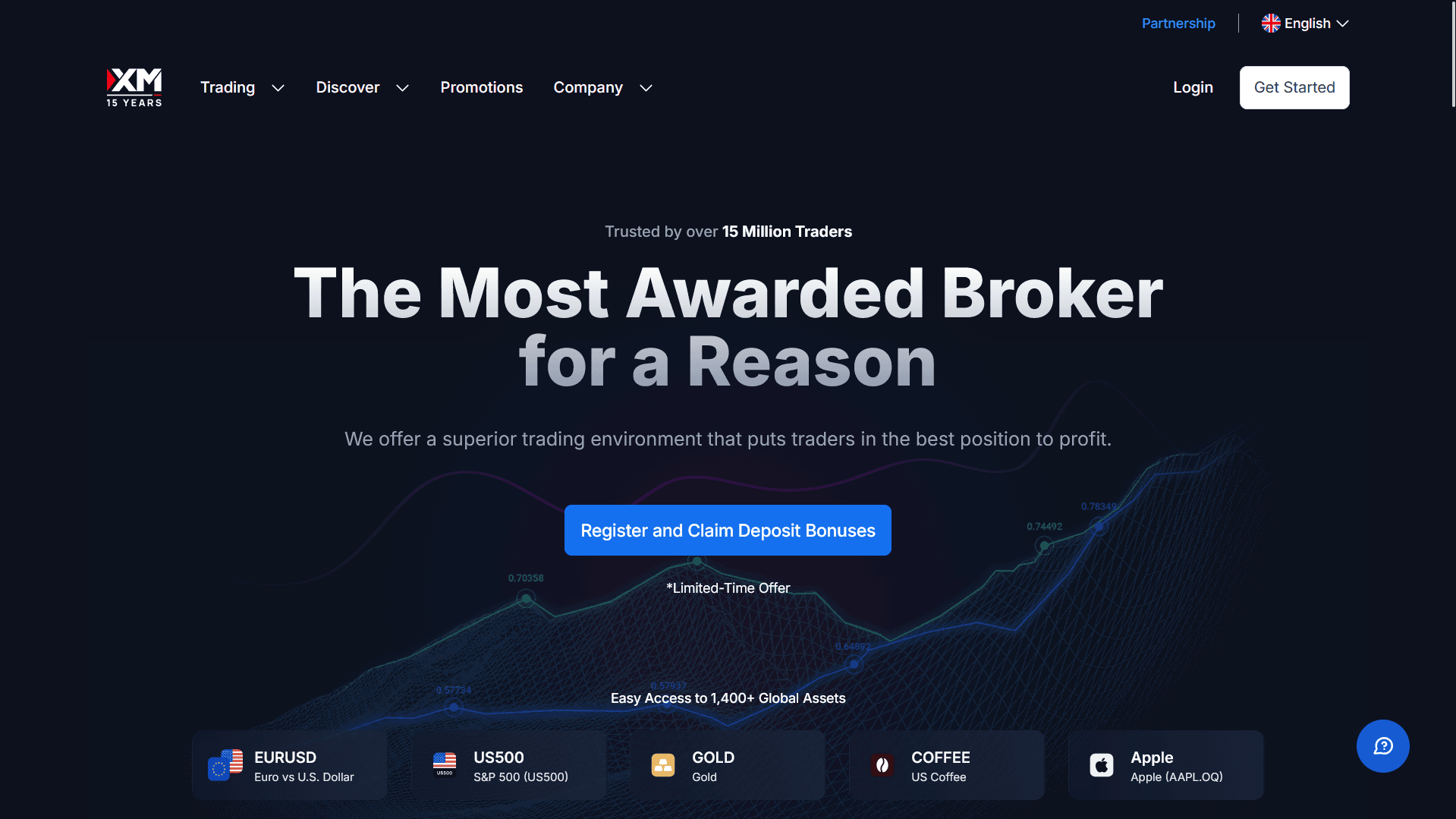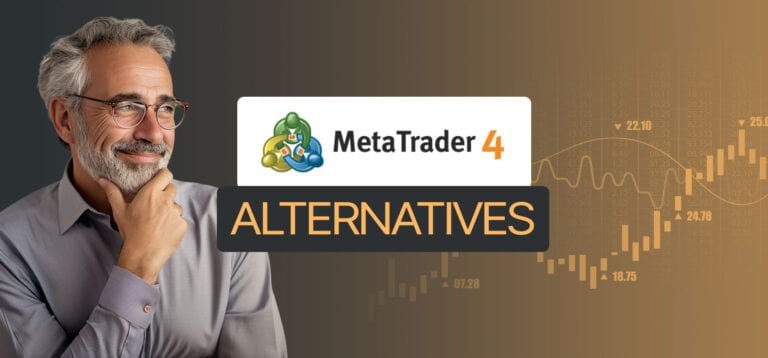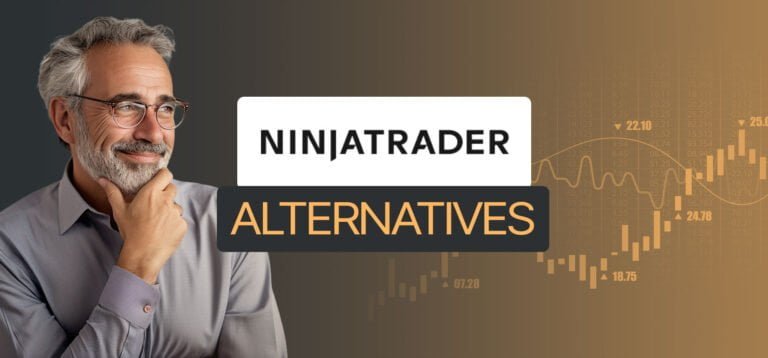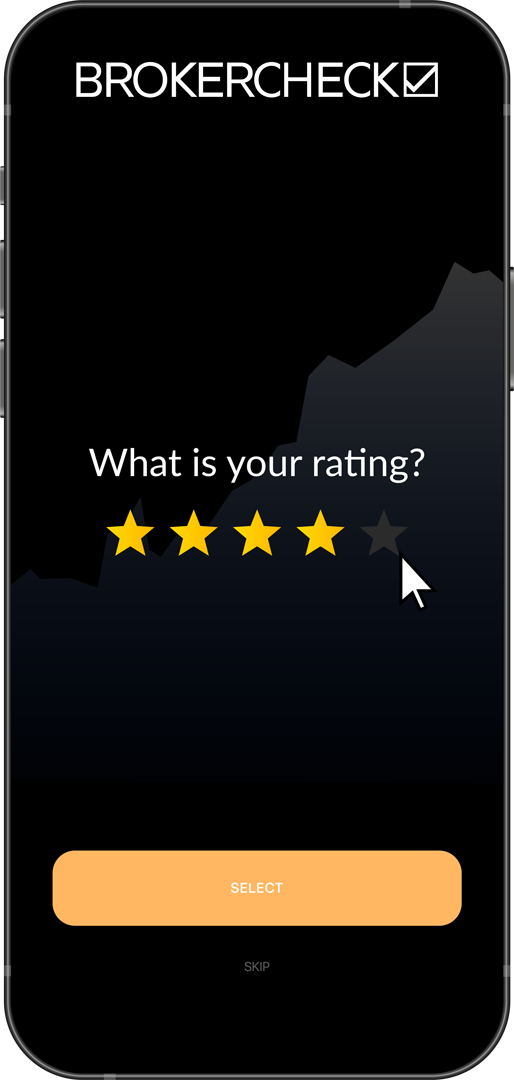1. Introduction
When delving into the world of online trading, platforms like MetaTrader and NinjaTrader emerge as the industry leaders, each having its own unique set of functionalities and advantages. One of the most pivotal attributes of these platforms is their ability to connect with numerous brokers, thereby providing users with a diverse range of trading opportunities. For instance, MetaTrader, developed by MetaQuotes Software, supports a multitude of brokers and offers advanced charting capabilities, automated trading through the use of Expert Advisors (EAs), and a marketplace for trading apps.
NinjaTrader, on the other hand, known for its advanced analytics, provides traders with comprehensive tools for strategy creation, high-performance backtesting, and trade simulation. It also features advanced alerting capabilities, enabling traders to be swiftly informed about market changes. Moreover, a notable advantage of NinjaTrader is its visual ‘point-and-click’ interface for designing custom trading strategies without the need for programming knowledge.
Apart from the aforementioned, both of these platforms offer a rich variety of technical analysis tools and indicators that can help traders in making informed decisions. MetaTrader excels in its offering of built-in technical indicators, scripts, and the ability to create and customize one’s own indicators. It also provides a wide range of timeframes, from one minute to one month. However, where MetaTrader really shines is in its programming language, MQL, which allows users to develop their own EAs, scripts, and indicators.
NinjaTrader also boasts a comprehensive suite of technical analysis tools, including advanced charting, trade simulation, and market analytics. One area where NinjaTrader stands out is its emphasis on advanced trade management (ATM) technology, which is designed to protect profits and limit losses. Additionally, NinjaTrader’s innovative ‘Market Replay’ feature allows traders to practice their trading skills in a simulated environment, using historical market data – an edge that is rarely found in other trading platforms.
1.1. Brief Overview of MetaTrader and NinjaTrader
In the world of online trading, MetaTrader and NinjaTrader are two of the most popular platforms that traders use to manage their activities. MetaTrader, developed by MetaQuotes Software, comes in two main versions: MetaTrader 4 (MT4) and MetaTrader 5 (MT5). On the other hand, NinjaTrader, developed by an American-based company of the same name, has carved out a reputation as a leading platform for advanced traders.
MetaTrader is highly regarded for its user-friendly interface, robust charting capabilities, and wealth of built-in indicators. It’s particularly popular among Forex traders due to its functionality and support for automated trading through the use of Expert Advisors (EAs). Both MT4 and MT5 offer real-time access to market prices, a variety of order types, and detailed trading history. The key difference between the two versions is that MT5 is more advanced and offers additional features including an economic calendar, depth of market, and more timeframes.
However, NinjaTrader holds its own with a feature-rich environment that caters to the needs of professional traders. It comes with advanced charting capabilities, trade simulation, market analysis, and strategy development tools. What sets NinjaTrader apart is its focus on providing tools for strategy backtesting, optimization and automation – features that can be highly beneficial for experienced traders.
Both platforms support algorithmic trading, but they do it differently. MetaTrader utilizes its proprietary MQL4 or MQL5 (for MT4 and MT5 respectively) language, whereas NinjaTrader uses C#, which is a more common and flexible language. This means that while creating automated strategies might be easier in MetaTrader because of its simpler programming language, NinjaTrader offers more possibilities for customization and optimization.
In terms of market access, while MetaTrader is largely limited to Forex and CFDs, NinjaTrader offers a wider range including futures and equities. However, your choice of broker might limit what you can trade, as not all brokers support all market types on these platforms.
1.2. Purpose of the Blog Post
In the world of online trading, the use of trading platforms like MetaTrader and NinjaTrader has become increasingly prevalent. Both platforms provide a variety of features and tools that can greatly enhance the trading experience, but they each have their unique strengths and weaknesses. Essentially, the choice between MetaTrader and NinjaTrader can significantly influence your trading strategy and outcomes.
MetaTrader, particularly its latest version MetaTrader 5, is praised for its user-friendliness and extensive back-testing capabilities. It supports a wide range of instruments, including forex, futures, and CFDs, and offers sophisticated automation tools, allowing traders to program and execute their trading strategies seamlessly. The platform also boasts a huge online community, providing a plethora of custom indicators, scripts, and expert advisors shared by its members.
On the other hand, NinjaTrader is known for its advanced charting and analytics tools. The platform is highly customizable, allowing traders to tailor their trading environment according to their preferences. One notable feature of NinjaTrader is its Market Replay function, which enables traders to replay historical market data at their own pace for practice and strategy testing. It is also recognized for its superior customer support and educational resources, which are valuable for beginner and intermediate traders.
However, neither platform is without its drawbacks. MetaTrader, for instance, requires a certain level of programming knowledge to fully utilize its automation tools. Its user interface, while intuitive, may seem outdated compared to other modern platforms. Likewise, NinjaTrader can be intimidating for beginners due to its complexity. The platform’s premium features also come with a price tag, making it less accessible for traders on a budget.
1.3. Why the Comparison is Relevant
In the world of trading, every tool, every feature, and every split-second can mean the difference between a windfall profit and a devastating loss. Choosing a trading platform is, therefore, crucial and could potentially dictate the course of your trading journey. This is precisely the reason why a comparison between MetaTrader and NinjaTrader, two of the leading platforms in the market, becomes highly relevant.
MetaTrader, developed by MetaQuotes Software, has been a robust and reliable trading platform for Forex, Futures, and CFDs. It’s intuitive, user-friendly interface, coupled with a rich set of features, such as automated trading, a variety of built-in indicators, and a comprehensive scripting language, has made it the platform of choice for many traders across the globe. But, it’s not without its limitations. Some users have reported a lack of advanced order types and difficulty in back-testing strategies, amongst other things.
On the other hand, NinjaTrader has developed a strong reputation for its advanced charting capabilities and comprehensive set of order types. It’s the go-to platform for technical traders who require advanced charting tools and compatibility with a host of third-party add-ons. NinjaTrader’s sophisticated strategy back-testing and trade simulation features further distinguish it from other trading platforms. However, the platform’s complexity and steep learning curve have been cited as drawbacks by some users.
The relevance of comparing these two platforms boils down to understanding your unique trading needs and preferences. For instance, if you are a beginner or a trader who mainly focuses on Forex trading, you may lean towards MetaTrader for its simplicity and foreign exchange market focus. Conversely, if you’re an advanced trader or prioritize advanced charting and back-testing, NinjaTrader may be the more suitable platform for you.
Furthermore, costs and fees associated with each platform should also be taken into account. MetaTrader is generally offered for free by most brokers, while NinjaTrader has both free and paid versions with varying levels of functionality. Lastly, the availability and quality of customer support from these platforms could also swing your decision in favor of one over the other.
2. Detailed Overview of MetaTrader

MetaTrader, developed by MetaQuotes Software, is a widely used trading platform that has established itself as a leading interface in the online trading industry. With the platform being available in different versions, MetaTrader 4 (MT4) and MetaTrader 5 (MT5), it caters to different trading styles with a unique set of features for each.
MetaTrader 4 is quite popular among forex traders due to its simplicity and robustness. It offers a comprehensive suite of charting tools, enabling traders to analyze the financial markets with precision. Users can customize the charting interface to their preference, using price overlays, technical indicators, and drawing tools. Its key features include an automated trading capability through Expert Advisors (EAs) and a backtesting functionality to test trading strategies against historical data. The platform also supports multiple order types, including market, limit, stop, and trailing stop orders, allowing traders to execute trades based on their strategies.
On the other hand, MetaTrader 5 is a more advanced platform that supports trading in multiple asset classes, including stocks, commodities, and futures, in addition to forex. MT5 extends the core functionality of MT4, offering more technical indicators, timeframes, and graphical objects. Furthermore, traders can open more than one account and manage them from the same interface, which is a significant advantage for those with diversified portfolios. One of the distinguishing features of MT5 is its depth of market (DOM) feature that presents market liquidity and depth in real-time, a vital tool for day traders and scalpers. The platform also has an integrated economic calendar and a news feed to keep traders updated on market events and news.
While MetaTrader platforms are preferred for their user-friendly interface and resourcefulness, some traders find their programming language, MetaQuotes Language (MQL), complex, especially when customizing EAs and technical indicators. However, there is a vast online community and a marketplace where users can buy or download for free thousands of EAs and indicators developed by other traders.
Moreover, MetaTrader platforms have integrated social trading features, enabling traders to copy the trades of experienced traders, which can be beneficial for beginners. Plus, with their mobile trading apps, users can manage their trades on the go, which adds to the convenience of trading.
Lastly, MetaTrader platforms are known for their high-security standards. All data exchange between the client terminal and the platform servers is encrypted. Moreover, the platform supports RSA digital signatures, further enhancing the security of trading operations.
With its rich set of features, customization options, and robust security measures, MetaTrader provides a comprehensive trading solution for traders of all experience levels.
2.1. History and Background of MetaTrader
MetaTrader, a leading platform in the world of forex trading, was created by the software company MetaQuotes Software Corp. The company was established in 2000 and is based in Cyprus. MetaQuotes launched its first version of the MetaTrader platform, the MetaTrader 1, in 2002. The platform was a success due to its advanced charting capabilities, automated trading features, and the ability to support a multitude of trading orders.
However, it was the launch of MetaTrader 4 (MT4) in 2005 that sealed the platform’s reputation in the forex trading world. MT4 provides an impressive array of tools for technical analysis, including over 50 in-built indicators and tools for charting. Originally designed for forex trading, MT4 later expanded to include other instruments like CFDs and futures. It has an interface that is customizable to individual trading preferences, and its MQL4 IDE feature enables the development of trading robots and technical indicators.
The successor to MT4, MetaTrader 5 (MT5), was introduced in 2010. Despite initial resistance, MT5 has gradually gained traction, especially due to its enhanced functionalities. MT5 offers additional timeframes, more technical and fundamental analysis tools, an expanded number of pending order types, a built-in economic calendar, and an upgraded strategy tester for EAs. It also integrates with MQL5 community services, offering ready-to-use trading signals and free trading robots.
Interestingly, both MT4 and MT5 continue to coexist in the forex trading space. While MT4 remains the de facto choice for forex trading, MT5 is increasingly embraced for trading a broader array of financial instruments. The enduring strength of MetaTrader platforms can be attributed to their comprehensive trading and analysis features, automated trading capabilities, and the support for the creation and integration of custom indicators and Expert Advisors (EAs).
2.2. Key Features of MetaTrader

MetaTrader, available in both MetaTrader 4 (MT4) and MetaTrader 5 (MT5) versions, is a widely recognized and user-friendly platform that provides various features suitable for both beginner and professional traders. One of the key features of MetaTrader is its advanced charting capabilities. Offering real-time data, multiple time frames, and over 30 built-in technical indicators, MetaTrader gives traders the tools necessary to perform detailed market analysis.
Another standout feature is the MetaTrader Market, an online store where traders can buy or rent trading robots and indicators directly from experts. With these tools, traders can automate their strategies, eliminating emotion and simplifying decision-making processes.
MetaTrader also offers Algorithmic Trading, which allows traders to develop, test and apply Expert Advisors (EAs) and technical indicators. This eliminates the need for routine market watch, enabling traders to focus on strategy fine-tuning.
Multi-terminal Trading is another feature that sets MetaTrader apart. This functionality allows traders to manage multiple trading accounts simultaneously, making it particularly useful for those managing portfolios on behalf of others.
Furthermore, MetaTrader includes the MetaQuotes Language (MQL) – a proprietary scripting language. MQL makes it possible for traders to program their own trading robots, scripts, and custom indicators, thus fully customizing their trading experience.
Finally, the Mobile Trading feature of MetaTrader is also worth mentioning. This feature provides traders with access to financial markets from anywhere at any time, enabling them to monitor and control their trades even when they are on the move.
Moreover, in terms of post-trade services, MetaTrader provides detailed trading history logs. By facilitating easy performance tracking, these logs enable traders to tweak and improve their strategies based on past trading behavior.
The overall versatility, customization options, and advanced trading tools that MetaTrader offers make it a preferred platform for various types of traders – from novices breaking into the trading world to experienced traders seeking sophisticated trading tools and functionality. The platform’s rich selection of features and tools offer traders the flexibility and control needed to navigate the ever-changing and often volatile trading landscape successfully.
2.3. Pros and Cons of MetaTrader

When it comes to using MetaTrader, there are a few key advantages that users often cite. First and foremost, MetaTrader is incredibly user-friendly. It’s designed to be accessible to traders of all experience levels, and its interface is intuitive and straightforward. This ease of use extends to its charting capabilities. MetaTrader offers advanced charting features that allow users to closely monitor market trends and make informed trading decisions.
Additionally, MetaTrader is known for its impressive customizability. Users can tailor their trading workspace to their specific needs and preferences, and can even create custom indicators and alerts. This level of customizability can make trading more efficient and effective, particularly for those with specific trading strategies.
MetaTrader’s automation capabilities are another significant draw. The platform supports algorithmic trading, which means users can set up automated trading systems to execute trades on their behalf. This can save a great deal of time and effort, and can also help to remove emotion from the trading process — a factor that can often lead to suboptimal trading decisions.
However, MetaTrader is not without its downsides. For starters, while its advanced features and customizability are strengths, they can also represent a learning curve for beginners. Those new to trading might find the array of options and settings to be overwhelming at first.
Another common criticism of MetaTrader is its limited asset coverage. While it supports trading in forex and CFDs, it lacks support for certain other instruments like stocks and bonds. This might not be an issue for traders who specialize in forex or CFDs, but it could be a dealbreaker for those who want to trade a wider range of assets.
3. Detailed Overview of NinjaTrader

As an advanced trading platform, NinjaTrader offers a rich variety of functionalities catering to both beginner and seasoned traders. A striking feature of this platform is its advanced charting capabilities. With a broad array of chart styles, from traditional candlestick charts to more complex Renko and Kagi charts, traders can customize their visual data analysis extensively, catering to their specific trading styles and strategies.
Moreover, NinjaTrader is quite popular for its backtesting and automation features. Backtesting allows traders to test their trading strategies against historical market data, providing insights into how these strategies would have performed in the past. Combined with its automation capabilities, traders can set up their strategies to execute trades automatically based on their specified criteria, minimizing human intervention and emotion in trading decisions.
NinjaTrader also shines through its Trade simulation feature. This allows beginners to practice trading in a risk-free, simulated environment before venturing into live trading with real money. The trade simulator mimics live market conditions, providing an authentic trading experience without the financial risk.
In terms of Order Entry, NinjaTrader supports various order types, including Market, Limit, Stop Market, Stop Limit, and more. Traders have the flexibility to place orders directly from the chart, the SuperDOM (Dynamic Order Modification window), or the Basic Entry window. Each of these windows provides different features depending on the trader’s preference and trading style.
Market Analytics is another area where NinjaTrader excels. Traders have access to real-time market analysis tools, such as alert systems and market scanners, which can be customized to track specific markets or instruments. These tools can help traders spot potential trading opportunities more effectively.
For those interested in algorithmic trading, NinjaTrader‘s NinjaScript is an invaluable tool. This C#-based programming language allows traders to create custom indicators, strategies, and drawing tools. Advanced traders and developers can even build their own add-ons using NinjaScript, extending the platform’s functionality to fit their unique needs.
3.1. History and Background of NinjaTrader
To understand the essence of NinjaTrader, we need to delve deep into its roots. Being a significant player in the trading software world, the platform first saw the light of day in 2003, conceptualized and developed by its parent company, NinjaTrader Group, LLC. Based in Denver, Colorado, the company aimed to create a comprehensive trading platform that catered to both beginner and experienced traders. Their prime focus was to provide industry-leading solutions for active traders, empowering them with advanced technical analysis tools.
NinjaTrader’s initial version was a simple charting software, but over time, it evolved into a complete trading solution, offering a trading simulator, trade management, market analytics, and automated trading capabilities. Its dynamic evolution was driven by the need to keep traders equipped with advanced tools to navigate the complexities of financial markets. This development was reflected in subsequent versions, NinjaTrader 6.5 and NinjaTrader 7, which offered significant improvements, including advanced trade management features and extended data feed support.
The launch of NinjaTrader 8 in 2016 was a significant moment in its history, as it introduced a host of new features and upgrades, further enhancing the platform’s appeal to traders. This included the addition of enhanced alerting systems, expanded drawing tools, multi-time frame analysis, and improved overall performance. In addition, the software was designed to be highly customizable, allowing traders to tailor it to their specific trading needs and preferences.
NinjaTrader’s journey is not just limited to software development. In 2014, the company also launched its own brokerage, NinjaTrader Brokerage, a move aimed at offering users a seamless trading experience by integrating brokerage services with their platform. Today, it supports trading in futures and forex, standing as a direct competitor to the likes of MetaTrader in these markets.
Over the years, NinjaTrader has indeed stood the test of time, proving its resilience and adaptability in an ever-changing financial marketplace. Its continuous innovation and user-oriented approach have attracted a growing user base, making it one of the most respected and widely-used trading platforms globally. Despite the competition from other trading platforms like MetaTrader, NinjaTrader has managed to carve its own niche, offering a unique blend of features that cater to a wide range of trading styles and strategies.
3.2. Key Features of NinjaTrader

The NinjaTrader platform boasts a rich array of features that cater to both novice and experienced traders. One of the standout features of NinjaTrader is its advanced charting capabilities. Traders can customize, backtest, and deploy their own automated trading strategies using the NinjaScript programming language. The platform’s extensive range of indicators and tools, such as Gann, Fibonacci and Elliot tools, allow traders to tailor their trading experience to their unique needs and preferences.
Another key feature of NinjaTrader is its market replay function. This feature allows traders to replay trading sessions in real time, or accelerated mode, facilitating a thorough analysis of market conditions and trade decisions. Additionally, NinjaTrader provides a simulated trading environment where traders can practice their strategies and techniques without risking real money. This simulated environment closely mimics a live trading setting, offering invaluable experience for beginners.
Trade management is another area where NinjaTrader excels. The platform offers advanced order handling capabilities, including multiple order entry options, automatic stop loss and profit target orders, and the ability to scale in and out of trades. The platform also provides specialized order handling for Forex trading, with features like single-click order execution and the ability to place complex order strategies.
Furthermore, NinjaTrader offers a market analyzer that enables traders to scan and filter markets based on their criteria. This feature, coupled with the platform’s advanced alert system, can help traders stay on top of market movements and changes in volatility.
NinjaTrader also boasts extensive data feed compatibility. The platform supports a wide range of data providers, from free end-of-day data to premium real-time data feeds. This flexibility makes it possible for traders to choose the data feed that is most suitable for their trading needs.
3.3. Pros and Cons of NinjaTrader

Starting with the positives, the NinjaTrader platform is recognized for its superior charting capabilities, which is an essential aspect for day traders and technical traders who rely heavily on analyzing price charts to make their trading decisions. Its advanced and highly customizable charts offer a plethora of options to users, making it a preferred choice for many. Another quality that sets it apart is its simulated trading feature. This helps beginners to practice their trading strategies in real-time without risking their real capital. In addition to these, NinjaTrader provides a large ecosystem of third-party add-ons, offering a sea of trading tools and indicators for users to choose from.
Moving on to the customer service, users have appreciated its responsive and hands-on customer support that is ready to help you navigate through the complexities of the platform. Also, the trader community around NinjaTrader is quite active, offering peer-to-peer support and shared knowledge.
However, NinjaTrader is not without its drawbacks. One of the most often noted is its complexity and steep learning curve, especially for novice traders. It takes time and patience to learn and navigate it, which could be overwhelming for beginners. Furthermore, the platform can be limited in terms of broker integration. While it has some partnerships, it might not cover all brokers, especially those outside of the US. This might limit its use for some traders depending on their preferred broker.
There’s also the issue of cost. NinjaTrader is not entirely free. While it does offer a free version, the functionality is limited. To access all the features, users must upgrade to a paid version. This can be a significant drawback for traders who are budget conscious or just starting out and not willing to invest in a trading platform.
4. Direct Comparison Between MetaTrader and NinjaTrader
The first significant distinction to recognize is the difference in the primary function of each platform. MetaTrader, predominantly designed for Forex trading, offers a comprehensive library of technical analysis tools, automated trading capabilities, and multiple order types. Conversely, NinjaTrader was primarily created for futures trading but has since expanded to support other instruments. It also offers advanced technical analysis tools and customizable charts but is highly esteemed for its robust trade simulation features, which are invaluable for new traders seeking to test strategies without financial risk.
Automated trading is another area where these platforms differ significantly. MetaTrader is well-known for its Expert Advisors (EAs), scripts that automate trading and analytic tasks in MQL4 or MQL5 language. This built-in feature allows for backtesting and optimization of EAs, providing traders with a high degree of automation and flexibility. NinjaTrader, on the other hand, supports automated trading via NinjaScript. While it’s a powerful tool, it may take longer to learn and is less intuitive than MetaTrader’s EAs, making it more suitable for experienced traders.
Charting capabilities should also be considered when comparing MetaTrader and NinjaTrader. Both platforms offer a wide range of charting options, but NinjaTrader stands out due to its highly customizable charting interface, multi-timeframe analysis, and diverse range of indicators. While MetaTrader also provides a variety of charts and indicators, the level of customization and the intuitiveness of its interface are not as sophisticated as NinjaTrader’s.
In terms of costs, MetaTrader has an edge for being free to use, with costs incurred through spreads and commissions from brokers. NinjaTrader, on the other hand, offers a free version with limited features, but to unlock its full potential, you need to purchase a license, which could be a significant cost depending on your trading activity and demands.
Lastly, data feed compatibility is a crucial aspect to consider. MetaTrader is typically tied to the broker’s data feed, with little flexibility. In contrast, NinjaTrader supports a broader range of data feeds, including real-time futures data from various sources. This flexibility could be a deciding factor for traders who rely heavily on specific data sources.
4.1. User Interface Comparison
When it comes to evaluating the user interface of trading platforms, both MetaTrader and NinjaTrader have their unique strengths and areas for improvement. MetaTrader, being a more established platform, offers a user-friendly interface that is easy to navigate, even for novice traders. The platform is intuitively designed with clear menus, buttons, and charts, allowing traders to quickly access the tools and features they need.
On the other hand, NinjaTrader presents a more advanced and customizable user interface, which may appeal to seasoned traders. The platform’s interface is highly configurable, with the ability to arrange windows and tabs according to the trader’s preferences. Moreover, NinjaTrader offers a rich set of advanced charting tools, including custom indicators and strategies, which can provide traders with a more comprehensive and tailored trading experience.
However, it’s important to note that the complexity of the NinjaTrader interface can be overwhelming to beginners. The platform’s advanced features and settings may require a steeper learning curve compared to MetaTrader. In contrast, MetaTrader’s simplicity may not cater to the needs of advanced traders, who might require more sophisticated tools and customization options.
When it comes to charting capabilities, both platforms perform exceptionally. MetaTrader provides nine different timeframes, from one minute to one month, allowing traders to analyze price movements at different periods. On the other hand, NinjaTrader offers a broader range of chart types, such as Renko, Point & Figure, and Kagi, providing more flexibility in technical analysis.
In terms of order execution, both platforms offer multiple order types, including market, limit, and stop orders. However, NinjaTrader stands out with its SuperDOM feature, which provides a dynamic depth of market view and quick order entry and modification.
Automated trading is another critical area to consider. Both MetaTrader and NinjaTrader support automated trading, with MetaTrader’s MQL4 and MQL5 programming languages and NinjaTrader’s NinjaScript. While both languages allow the creation of custom indicators, scripts, and automated trading strategies, some traders might find MQL4 and MQL5 more accessible and easier to learn than NinjaScript.
4.2. Feature Comparison
When comparing the features of MetaTrader and NinjaTrader, there are several important differences to note. Firstly, one of the most distinguishing features of MetaTrader, particularly MetaTrader 4, is its widespread use and acceptance by a large number of brokers. This makes it a highly flexible platform for traders who wish to work with different brokers. The platform also offers a rich set of functionalities, including over 50 technical indicators, a comprehensive charting package, and an extensive back-testing environment. Additionally, MetaTrader boasts a sophisticated and fully customizable scripting language, MQL4 or MQL5, depending on the version used, which allows users to create and employ their own indicators and automated trading algorithms.
NinjaTrader, on the other hand, excels in the field of trade management. With features like semi-automated and fully automated trade management, it provides users with a high degree of control and flexibility over their trades. Furthermore, NinjaTrader’s advanced charting capabilities are worth mentioning, offering a wide range of chart types and trading from the chart functionalities, in addition to its Market Replay feature which allows traders to replay trading sessions for practice. In terms of customizability, NinjaTrader’s NinjaScript is a C# based language that enables users to design their own trading strategies and indicators, though it may have a steeper learning curve compared to MetaTrader’s MQL.
However, one significant distinction between the two platforms is their compatibility with various markets. MetaTrader is primarily designed for forex trading, yet it also supports other market types, including commodities and indices, depending on the broker. NinjaTrader offers a broader market compatibility, supporting not only forex but also futures, options, and stocks.
Another critical factor to consider is the cost. MetaTrader is generally free for its basic functionalities, with additional features or plugins possibly incurring extra charges. Conversely, while NinjaTrader can be used for free for advanced charting, backtesting, and trade simulation, live trading requires purchasing a license, or trading through a NinjaTrader-affiliated broker.
Lastly, both platforms have distinct approaches to community support. MetaTrader, being more widespread, has a large online community where users can share or sell their custom scripts or expert advisors. NinjaTrader also offers a vibrant community, NinjaTrader Ecosystem, which provides resources for education, add-ons, and programming services.
4.3. Pricing Comparison
When it comes to choosing the best trading platform for your needs, the cost is inevitably a crucial factor to consider. Both MetaTrader and NinjaTrader offer unique pricing structures that cater to different types of traders. Knowing the specifics of each will help you make a more informed decision.
MetaTrader, for instance, is a free platform for its users. However, this doesn’t mean that using this platform is completely cost-free. In reality, brokers who present MetaTrader to their customers incur costs, which are often passed on to the traders in the form of wider spreads or additional commissions. Therefore, while the platform itself may not charge a fee, using MetaTrader might add to your trading costs indirectly.
Contrary to this, NinjaTrader offers its platform in a freemium model. Meaning, you can use it for free for advanced charting, strategy backtesting, and trade simulation. However, if you wish to use its trade automation, real-time trading, or use premium features, you need to purchase a license. NinjaTrader presents three different licensing options: a lifetime license for a one-time payment of $1099, a lease plan which costs $720 per year, and a quarterly lease available for $225. In addition, NinjaTrader also charges certain commissions per traded lot, which depends on the market you trade.
It’s also worth noting that with NinjaTrader, you can choose your brokerage, which can give you the flexibility to find competitive pricing and a chance to cut costs. However, with MetaTrader, you’re typically tied up with the broker that provides you the platform, limiting your ability to shop around for the best trading conditions.
4.4. Community and Support Comparison
When exploring the world of forex and stock trading platforms, two names that often resonate are MetaTrader and NinjaTrader. A critical element to consider when choosing between these two platforms is the community and support offered by each.
MetaTrader, being a popular choice among traders globally, boasts a large and active community. This platform proudly hosts numerous forums and discussion boards where users can interact and share trading strategies, experiences, and troubleshooting tips. In addition, MetaTrader offers extensive online resources, including tutorials, webinars, and frequently asked questions (FAQs) sections, which are incredibly handy for new and experienced traders alike. Moreover, MetaTrader provides professional customer support available 24/5 to assist with any technical difficulties or queries.
On the other hand, NinjaTrader also presents a comprehensive support structure. With a dedicated support forum, users can exchange ideas, discuss issues, and seek advice from the community. Compared to MetaTrader, NinjaTrader’s user-base may be smaller, but it’s worth noting that it’s highly engaged and specialized. The company prides itself in providing exceptional customer service, with support available via email or phone. NinjaTrader also offers a wealth of educational resources, including a learning center, training webinars, and video library, catering to both novice and advanced traders.
However, one distinguishing feature of NinjaTrader’s support system is its unique ecosystem. The NinjaTrader Ecosystem is a dedicated space where users can access thousands of third-party trading applications and services, including indicators, strategies, and educational courses. This ecosystem not only offers tailored solutions but also connects traders with certified consultants, providing an extra layer of support.
5. Conclusion
In a side-by-side comparison, it’s evident that both MetaTrader and NinjaTrader offer a robust platform for trading, each with distinct strengths. MetaTrader, for instance, is recognized for its forex market specialty. It provides comprehensive charts, multiple time frames, and a vast array of built-in indicators that allow for advanced technical analysis. The platform is also known for its expert advisor (EA) functionality, enabling automated trading strategies with MQL4/5 programming. This is a powerful tool for traders who wish to automate their strategies based on specific market conditions.
NinjaTrader, on the other hand, is cherished for its versatile and customizable interface. It offers traders the flexibility to arrange their trading workspace according to their preferences, which can contribute significantly to their trading efficiency. In addition, NinjaTrader’s extensive backtesting capabilities, with the possibility to simulate trading strategies under historical market conditions, set it apart. Moreover, the platform supports C# programming, offering a wider range of possibilities for strategy development.
Interestingly, cost is another distinguishing factor between the two platforms. While MetaTrader is free for the majority of retail traders, NinjaTrader charges for its premium features such as advanced charting, strategy backtesting, and trade simulation. However, the cost is often justified by the enhanced functionality and flexibility it offers.
When it comes to compatibility, MetaTrader has a slight edge as it is supported by a broader range of brokers worldwide. It also offers mobile trading capabilities, making it more accessible for those who prefer to trade on the go. NinjaTrader is more U.S.-centric and is often favored by futures and commodities traders.
Lastly, the choice between MetaTrader and NinjaTrader will largely depend on the specific needs and preferences of the individual trader. Traders who focus on forex trading, prefer a widely-used platform, require mobile trading, or have budget constraints might lean towards MetaTrader. Conversely, those who value a customizable interface, require extensive backtesting tools, and are ready to invest in a platform for enhanced features might find NinjaTrader more suitable. The key is to identify which features align best with your trading style and goals.
5.1. Summarizing the Key Differences
First and foremost, we begin with the platform’s architecture. MetaTrader is primarily a forex trading platform, offering tools, indicators, and charts specifically designed to assist in forex trading. On the other hand, NinjaTrader provides a broader scope, supporting a multitude of asset classes such as futures, equities, forex, and more. This makes NinjaTrader a more adaptable platform, serving a wider range of trading needs.
Next, let’s talk about the user interface. While both platforms are user-friendly, they differ in their interface designs. MetaTrader is characterized by its traditional look, favoring functionality over aesthetics. In contrast, NinjaTrader comes with a modern, sleek interface providing a highly customizable workspace. This ability to personalize your trading environment may appeal to traders who value a visually pleasing and unique workspace.
The backtesting features of these platforms also show significant differences. MetaTrader, specifically its fifth version (MT5), offers a strategy tester feature enabling traders to backtest their trading strategies based on historical data. Meanwhile, NinjaTrader excels in this area with its advanced backtesting module, which not only allows for historical data testing but also enables high-speed backtesting with its Market Replay feature.
Automation capabilities are another point of comparison. Both platforms support automated trading through bots or expert advisors, but they differ in their programming languages. MetaTrader uses a proprietary language called MQL, with MT4 using MQL4 and MT5 using MQL5. In contrast, NinjaTrader utilizes C#, a widely used high-level language, making it arguably more flexible and accessible for coders.
Lastly, when it comes to broker compatibility, MetaTrader has a larger global reach, being compatible with a vast number of brokers worldwide. NinjaTrader, while having fewer broker partners, prides itself on its premium partnerships, offering direct market access to some of the world’s largest exchanges.
In sum, while both MetaTrader and NinjaTrader are robust trading platforms, they cater to different trader needs and preferences. Understanding these key differences can help traders make a more informed decision as to which platform suits their trading style and goals better.
5.2. Recommendations Based on Trading Needs and Preferences
Whether you lean towards MetaTrader or NinjaTrader as your preferred trading platform largely depends on your individual trading needs and preferences. Each platform has its strengths and weaknesses, and understanding these can help you make the most informed decision.
For example, if you’re a beginner or intermediate trader with a particular interest in Forex trading, then MetaTrader might be your best bet. Its user-friendly interface is easy to navigate even for beginners, and it offers a host of tools including advanced charting, a large number of technical indicators, and the ability to automate trading strategies using the MQL4 (MetaTrader4) or MQL5 (MetaTrader5) programming language.
On the other hand, if you’re a seasoned trader looking for a highly customizable platform with advanced functionalities, then NinjaTrader would be more suitable. NinjaTrader’s extensive range of in-depth analysis tools, as well as its advanced trade management features, make it a robust option for experienced traders. Furthermore, NinjaTrader also offers options for futures and equities trading in addition to forex.
The choice between the two also depends on your lifestyle and how you prefer to execute your trades. If you’re a trader who’s always on the go, MetaTrader‘s mobile app is robust and allows for trading from anywhere. However, if most of your trading is done from a desktop environment, NinjaTrader’s platform might be more appealing due to its complex features and depth of analysis tools.
Cost considerations also come into play when selecting a trading platform. MetaTrader is free to download and use, and most brokers offer it as a standard platform. On the contrary, while NinjaTrader is free for advanced charting, backtesting, and trade simulation, live trading requires purchasing a license or leasing the platform.
In terms of community and support, both platforms have extensive communities of users and developers, where you can share, discuss, and buy trading strategies or indicators. However, MetaTrader’s community is larger and more active, which might be beneficial if you rely on community support for trading ideas or troubleshooting technical issues.
Lastly, your preferred broker’s compatibility with these platforms is crucial. Most Forex brokers support MetaTrader, while fewer brokers are compatible with NinjaTrader. Ensuring that your chosen platform is compatible with your broker is key to smooth trading operations.
To conclude, both MetaTrader and NinjaTrader have strengths that cater to different trading needs and styles. Thoroughly assessing your requirements and preferences before deciding, will equip you with a platform that enhances your trading strategy and ensures a more efficient and effective trading experience.
6. References
In order to make an informed decision about which platform – MetaTrader or NinjaTrader – might best suit your trading needs, it’s essential to consider various credible sources and references. These may include user reviews, expert opinions, comparison articles, and the platforms’ official websites.
User reviews are particularly valuable as they provide first-hand experiences of traders who have used both platforms. They can offer insights on unique features, ease of use, customer support and reliability, among other aspects. Websites like Trustpilot, Forex Peace Army, and others offer hundreds of user reviews, providing a wealth of information about both MetaTrader and NinjaTrader.
Expert Opinions from reputable financial publications and websites are another useful reference. These experts have in-depth knowledge about financial trading and have usually tested these platforms themselves. They can provide objective, thorough analyses, and comparisons that take into account a broad range of factors. Websites such as Investopedia, DailyFX, and BabyPips often have expert analysis and articles on this topic.
Comparison articles found on trading blogs and forums can also be a treasure trove of information. They provide side-by-side comparisons of MetaTrader and NinjaTrader, highlighting the strengths and weaknesses of each platform. This can help you understand how each platform fares against the other on key parameters like trading tools, charting capabilities, automated trading features, and more.
Lastly, the official websites of MetaTrader and NinjaTrader are the primary sources of information about these platforms. They detail the full range of features, services, pricing, and support offered by each platform. While these sources may have a promotional tone, they are still valuable for understanding the platforms from the providers’ perspectives.
Remember, it’s essential to cross-reference information from different sources to obtain a well-rounded understanding of these trading platforms. And always take into account your individual trading needs and preferences when making the final decision.












